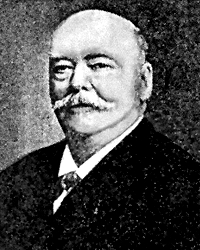Maurice Leblanc (engineer)
Charles Léonard Armand Maurice Leblanc (born March 2, 1857 in Paris , † October 27, 1923 ) was a French electrical engineer .
After completing his electrical engineering training at the École polytechnique in Paris, he worked briefly on the railroad.
After that, he was mainly concerned with improving electric motors and generators. He invented an improved vacuum pump and also worked in the field of cooling.
From 1875 he investigated the sluggishness of the human eye during rapid scanning processes in order to transmit colored images electrically.
On December 1, 1880, he published the article Etude sur la transmission électrique des impressions lumineuses in La Lumière électrique , in which he listed the five basic functions of a television system:
- A converter for converting light into electricity
- A scanner to break down the image into its components
- A method of synchronizing the transmitter and receiver
- A means of converting the electrical signals back into light
- A screen to look at the picture
He wanted to implement the scanning system with a prism to split the light into the seven spectral colors, mirrors and slit diaphragms. One selenium cell per spectral color should then control a relay .
1903-09 he was professor of electrical engineering at the Ecole des mines . On November 25, 1918 he became a member of the Académie des Sciences .
Web links
- Maurice Leblanc biography at ADVENTURES in CYBERSOUND
- Leblanc's television system - Article in French
Individual evidence
- ^ List of members since 1666: Letter L. Académie des sciences, accessed on January 10, 2020 (French).
| personal data | |
|---|---|
| SURNAME | Leblanc, Maurice |
| ALTERNATIVE NAMES | Leblanc, Charles Léonard Armand Maurice (full name) |
| BRIEF DESCRIPTION | French electrical engineer |
| DATE OF BIRTH | March 2, 1857 |
| PLACE OF BIRTH | Paris |
| DATE OF DEATH | October 27, 1923 |
